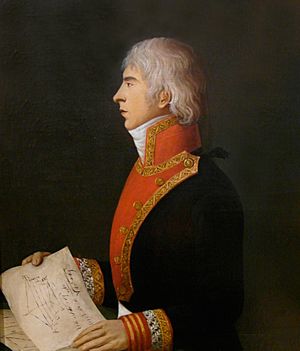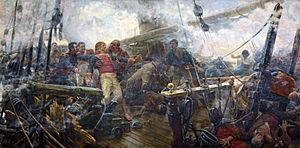Cosme Damián Churruca facts for kids
Quick facts for kids
Cosme Damián Churruca
|
|
|---|---|

Portrait of Cosme Damián de Churruca, Museo Naval de Madrid
|
|
| Birth name | Cosme Damián de Churruca y Elorza |
| Born | 27 September 1761 Mutriku, Gipuzkoa, Spain |
| Died | 21 October 1805 (aged 44) Trafalgar, Cádiz, Spain |
| Allegiance | |
| Service/ |
Spanish Navy |
| Years of service | 1778–1805 |
| Rank | Admiral |
| Commands held | Principe de Asturias San Juan Nepomuceno |
| Battles/wars | Battle of Trafalgar |
Cosme Damián de Churruca y Elorza (born September 27, 1761 – died October 21, 1805) was a brave Basque Spanish admiral and scientist. He was also the Mayor of Mutriku. He is famous for bravely commanding the ship San Juan Nepomuceno during the Battle of Trafalgar, where he fought until he died.
A Young Sailor's Life
Cosme Damián de Churruca was born in Mutriku, Spain. He was the fourth son of the town's mayor. He first studied in Burgos, even thinking about becoming a priest. Later, he joined the School of Bergara. There, he became a member of the Royal Basque Society of Friends of the Country.
Inspired by his relative José Antonio de Gaztañeta, Churruca decided to join the navy. He entered the Naval Academy of Cadiz in 1776. By 1778, he had finished his studies at the Naval Academy of Ferrol and became a naval officer.
In 1781, Churruca showed great courage as a Spanish Navy officer. He fought heroically during a siege of Gibraltar. His brave actions earned him a strong reputation. In 1805, just months before his death, Churruca married María Dolores Ruiz de Apodaca. She was the niece of Juan Ruiz de Apodaca, who was also a naval officer.
The Battle of Trafalgar
Churruca's ship, the San Juan Nepomuceno, sailed from Ferrol on August 13. General Gravina gave Churruca an important position at the front of the fleet. Churruca did his job very well. When he arrived in Cadiz, he worked hard to train his new and inexperienced crew. Around this time, he married Maria de los Dolores Ruiz de Apodaca.

The Spanish and French fleets joined together in Cadiz. They sailed towards Marticina, where they captured a British convoy of 16 merchant ships. At this time, Admiral Villeneuve, who led the combined fleet, learned that Admiral Nelson was in the Antilles. Villeneuve decided his goal was met: to draw British ships away. So, he planned to sail the combined fleet back to Ferrol.
However, near the Cape of Finisterre, they met Admiral Calder's British fleet. A battle took place. Most of the French ships continued to Ferrol, leaving others to fight alone. Many blamed Villeneuve's poor leadership for their defeat. Napoleon himself said, "The Spanish have behaved like lions, while their admiral only offered curses."
After the battle, the combined fleet went to Ferrol, then to La Coruña. From there, Villeneuve sailed to Cadiz, even though Napoleon had ordered him to go to Brest. Once in Cadiz, Villeneuve decided to leave the bay to meet Nelson at the Cape of Trafalgar. This was on October 21, 1805. Churruca and other Spanish admirals disagreed with this plan, but Villeneuve went ahead.
On October 21, the British fleet was in sight. Churruca gave a famous order: he had his ship's flags nailed to the mast. This meant they would not be taken down as long as he was alive. Under Churruca's command, the San Juan Nepomuceno fought with great skill and bravery. It faced six English ships alone, including HMS Defiance and HMS Dreadnought.
Churruca was hit by a cannonball that tore his leg. He died with the respect of his enemies. The British were so impressed that they displayed his ship in Gibraltar. They wrote his name in golden letters above his cabin. Visitors were told to remove their hats when entering, as if Churruca was still there. His officers kept their promise and only lowered the flags after he died. The San Juan eventually surrendered with over 100 dead and 150 wounded. This was done to prevent the ship from sinking with all the injured still inside.
Lasting Legacy
After his death, Churruca was given the rank of admiral. To honor him, his cousin received the title Count of Churruca. The story of Churruca was even made into a novel in 1872 by Benito Pérez Galdós. It was called Trafalgar and was the first book in his Episodios Nacionales series.

A statue stands in his memory in his hometown of Mutriku. There is also a monument in Ferrol that remembers his death. In San Fernando, a stone in the Pantheon of Illustrious Sailors reads:
To the memory of Brigadier of the Navy Don Cosme Damián de Churruca, gloriously dead on the ship of his command San Juan Nepomuceno in the combat of Trafalgar. 21 October in 1805
After the Battle of Trafalgar, the San Juan was taken by the British. It was first called HMS Berwick, but its Spanish name was later given back. To honor Churruca's bravery, his cabin had a brass plate with his name. Everyone who entered had to take off their hat as a sign of respect for such a brave enemy. HMS San Juan was used as a supply ship in Gibraltar until 1815, when it was taken apart.
In the 1942 Spanish film Raza, the main characters are a family who are descendants of Churruca. This film was based on a script by Francisco Franco, who was then the head of state. In 1976, Spain released a postage stamp showing Churruca to honor him.
See also
 In Spanish: Cosme Damián Churruca para niños
In Spanish: Cosme Damián Churruca para niños


